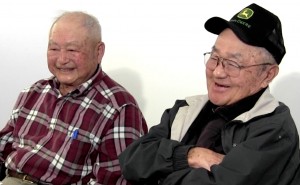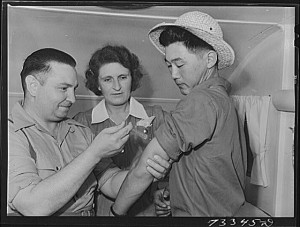Russell Lee in the Northwest: Documenting Japanese American Labor Camps in Oregon and Idaho
26 June 2013 – Morgen Young
As a full-time consulting historian, it is difficult to carve out time for my own research interests. Michael Adamson has discussed this challenge in this space.
In graduate school, I studied Farm Security Administration documentary photography. Upon starting my business, I found little time to continue my research–until a year ago. While researching images in the FSA collection, I found several hundred photographs of Japanese American labor camps in the Pacific Northwest, taken by Russell Lee in the summer of 1942. The sole Oregon camp–near the town of Nyssa in Malheur County–was created to bring in laborers for the sugar beet crop.
The camp was a product of the “Oregon Plan,” developed by George Aiken, Oregon governor Charles Sprague’s secretary, to put the state’s 4,000 Japanese American residents to work on land and transportation projects. Aiken presented the plan at an April 1942 conference organized by the War Relocation Authority and attended by officials from ten western states. When the WRA rejected the proposal, Sprague moved forward with a less ambitious plan. The result was the establishment of an FSA camp near Nyssa that authorized four hundred incarcerees to leave the Portland Assembly Center to work in Malheur County. It was the first labor camp created during the incarceration of Japanese Americans. By the end of 1942, approximately 10,000 incarcerees left centers for seasonal farm work in eastern Oregon, Idaho, Utah, Montana, and Colorado.
What began as an interest in a series of photographs has evolved into a multiphase project. The Oregon Cultural Heritage Commission (OCHC) is sponsoring the first phase, developing a traveling exhibition of a selection of Lee’s photographs. A large component of the exhibition project involves conducting oral history interviews with former camp residents, their families, and others. Through the OCHC, I secured grants for the projects and in April I traveled to Malheur County to record ten video oral histories.
The following is an excerpt from one interview:
Morgen Young: What do you remember about the Evacuation Order?
Yas Teramura: It had to be about the fifth of May when we went. They put us on a school bus and they took us to the Portland Assembly Center. When we got there, that was it. We couldn’t get out.
Bob Kido: It was the Pacific International Livestock Center.
YT: There were five of us in one room. We had to make our beds and stuff them with straw. The straw would poke you in the back. Can you imagine what we had to do?
BK: We had cots. I think we were privileged. I don’t know why.
MY: What could you take with you to the assembly center?
YT: The only thing you could take was whatever you could carry. I still have my suitcase, with the number on it and everything.
BK: My dad just bought me a BB gun, a brand new one. And they took that away from me. They just went through our house like you can’t believe, opened everything.
YT: One thing about the Japanese, most didn’t retaliate. They just went quietly. And that’s the way our parents were.
MY: How did you first hear about the Nyssa camp?
YT: The big shots at the sugar company had Roosevelt okay the Japanese to come work here. They were so hard up for help because everyone who worked was in the army. They were getting behind on the sugar beets. So we came over, but we were under tight restrictions. You could only stay out until eight o’clock at night and you couldn’t roam around, unless there was an armed guard.
MY: And you volunteered to go to the labor camp?
YT: The field man from the sugar beet company had a table and we signed up. Anybody over eighteen could sign up. Only a few families went, like Bob’s family and a couple of bachelors, like myself and Moose Kirabashi. I was nineteen years old.
MY: How did you get from Portland to Nyssa?
YT: By train. There was a guard on the train with a rifle. We couldn’t open the windows and we had to keep the blinds closed. When we got to Nyssa, we opened the windows and I saw a bunch of plants. I asked, “What is that green stuff?” One fellow had worked over here and he said “That’s sugar beets.” I thought it was turnips. I didn’t know.
To learn more about the project, please visit the Oregon Cultural Heritage Commission.
Yas Teramura and Bob Kido recorded a video oral history interview for the project in April 2013. Courtesy of Oregon Cultural Heritage Commission.
Nyssa, Oregon, 1942. Yas Teramura receives an inoculation from Dr. Lou Malding in the FSA mobile camp infirmary. Library of Congress, Prints & Photographs Division, FSA-OWI Collection, LC-USF34-073345-D.
~ Morgen Young, Alder LLC






When will the videos be available for others to see? I am from Malheur County and have done some oral histories (connected with the Ethnic Studies program at OSU) and am very interested in your work.
I grew up in Nyssa but after getting married moved to Texas. I would like to see the photographs of the labor camps when the Mexican American lived in them. I lived in the Nyssa Labor Camp and would like to see those picture.